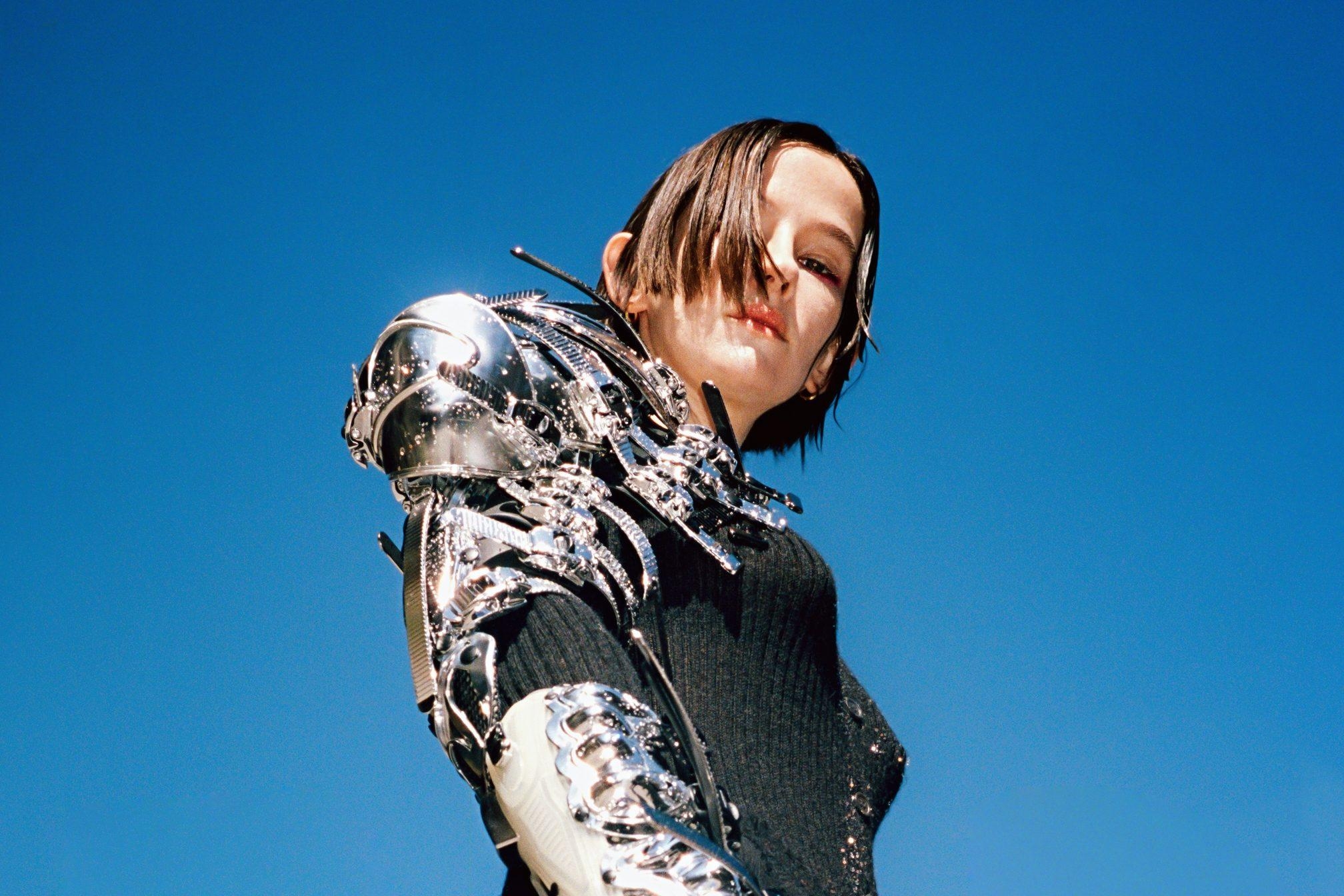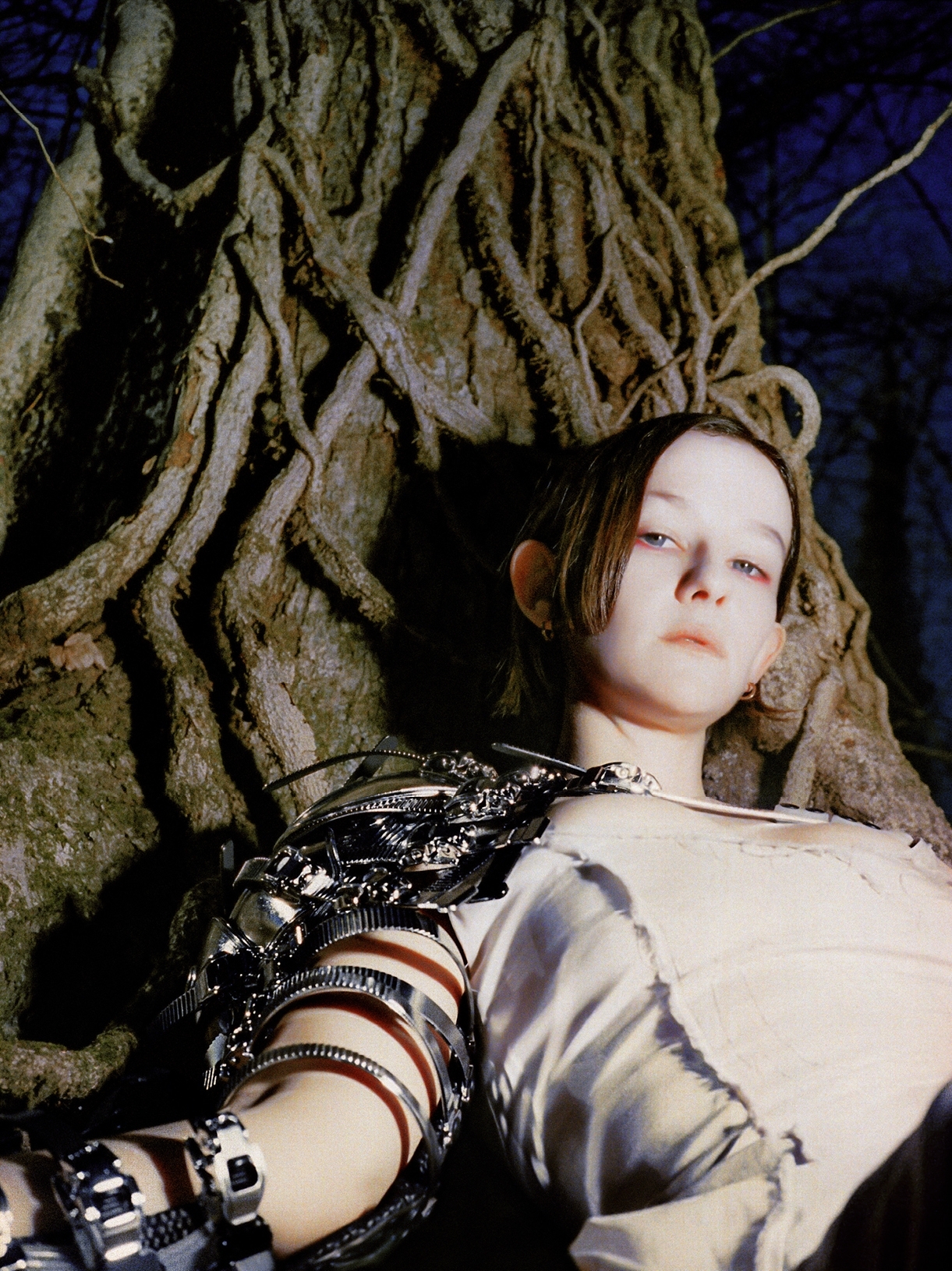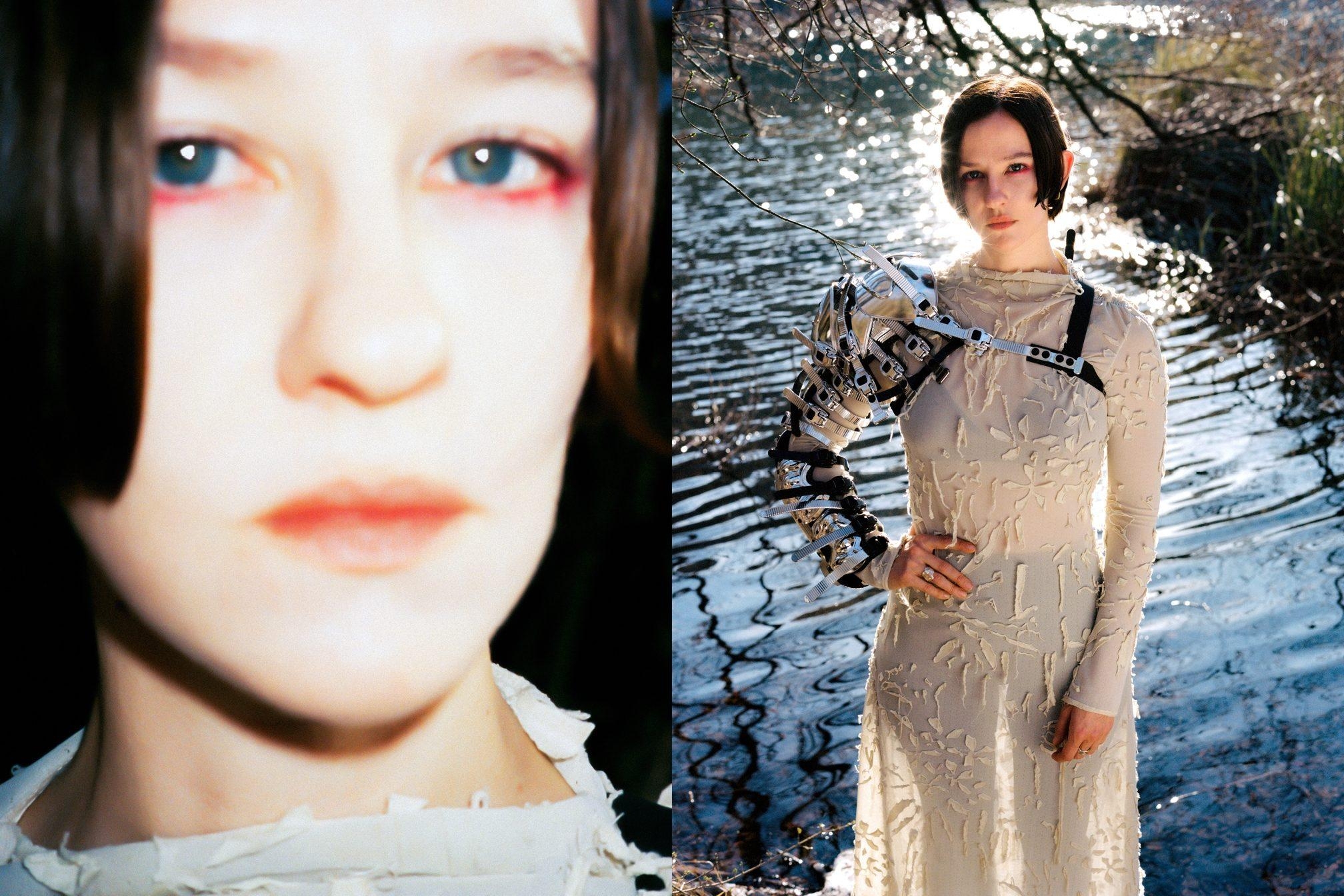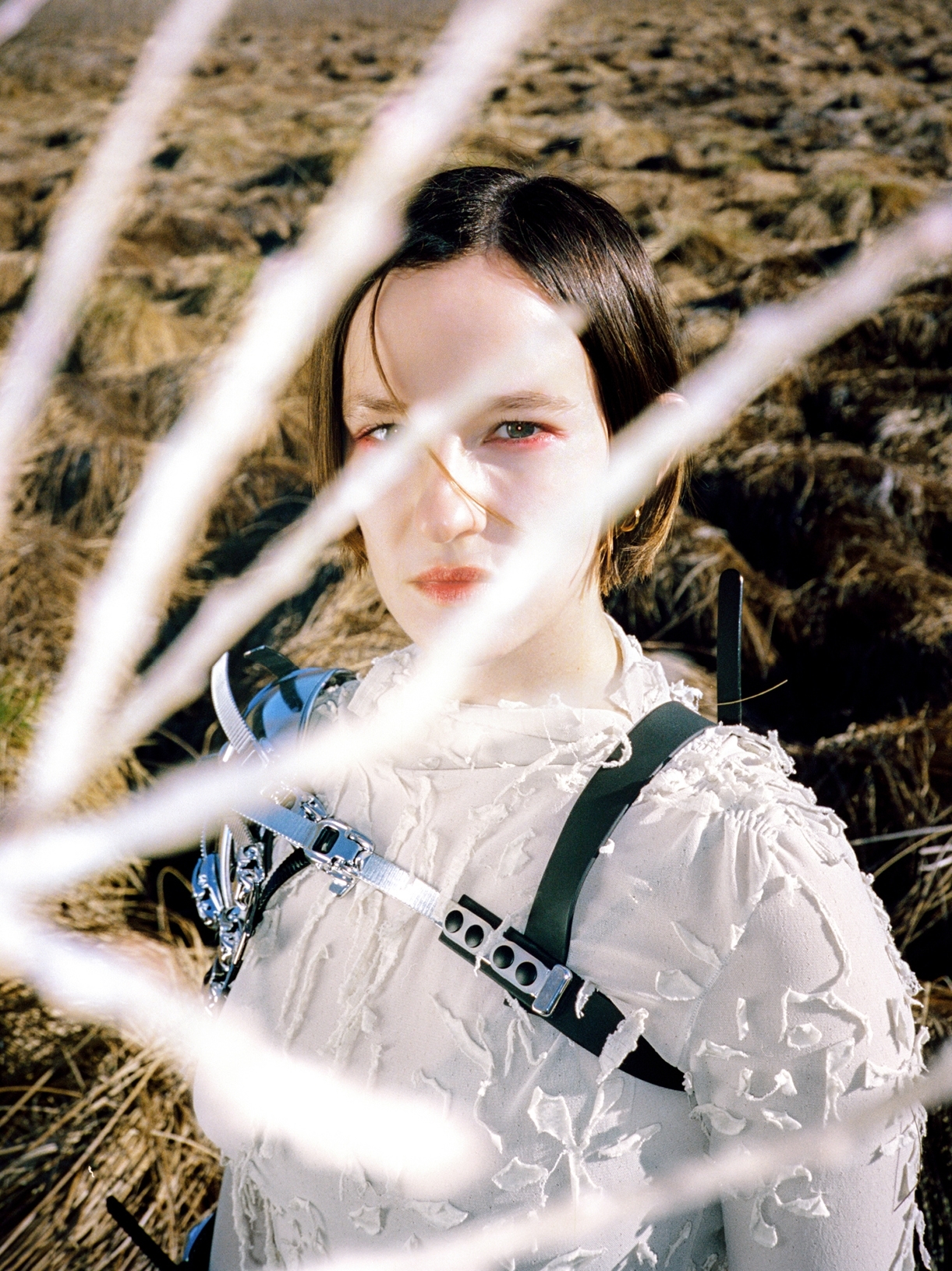 Features
Features
Modular mystic: Caterina Barbieri is unlocking the spirituality in synths
Chal Ravens speaks to Italian composer Caterina Barbieri about performing in imposing spaces, hating the 'modular music scene', and whether she might - one day - release music with a kick drum
There’s a glass elevator inside a mountain in Graz, Austria, which squeezes past 120 metres of sliced rock before popping up for a view over the red rooftops of the city. There are two lifts to choose between for the 30-second journey, and if you’re lucky, you’ll get the one with a celestial synth soundtrack by Caterina Barbieri. Think Music For Elevators, not elevator music.
Barbieri is used to hearing her music in weird places. Part psychedelic, part ecclesiastic, her austere synthscapes effect the kind of mind-body rinse-outs that work best in non-standard venues, from ruined churches to marble quarries and multi-storey car parks – anywhere you can’t stand at the bar chatting. With a modular rack and a blast of dry ice, her live solo show turns any building into an instrument. And in the same way that stripped-back techno seems to multiply in power when it’s blasting through a warehouse, her psychoacoustic minimalism demands outsized architecture.
The piped-in elevator music is the exception. “It's nice to associate music with this feeling of ascension and descension,” Barbieri points out. If you happen to step into the other lift, there’s a consolation prize. “Now there are two elevators,” she notes with pride, “one is with Brian Eno’s music and one is with mine.”

Like Eno, Barbieri is an electronic musician who spends more time thinking about sound itself – how it works in our brain, how it affects our sense of self – than she does thinking about how synths operate. And while her explanations can come across as formidably big-brained, what it boils down to is much more accessible. This is music designed to be heard live, in a room, in three dimensions (or more, depending on your suggestibility). This is music that asks: what happens if I play this one sawtooth wave, really fucking loud, in a really big space? What if I tweak the delay this much, and nudge the reverb that much? And what happens if I keep that sound going and going, round and round – until it blooms into a hypnotic whorl of kaleidosonic patterns? Freaky stuff, that’s what.
“For me, it's not so much about the technicalities, but more about a sort of philosophy of sound,” she says of her trance-inducing performances. “Sound is a framework that is very physical, but it can get quite metaphysical in terms of the conversations that you can have around it.”

Last year’s ‘Spirit Exit’ was an adverse reaction to pandemic isolation, an album of dense, song-like compositions inspired by women philosophers, poets and mystics. With her new album, she’s wiping the slate clean to return to the raw hypnosis of her earlier recordings. For the past few years the Bologna-born artist has been based in Milan, but back then she was still living in Berlin, touring constantly and testing out new ideas during her shows.
“The best ideas were surviving and the worst ideas were dying,” she recalls, explaining that much of her writing process happens on stage. “I approach music as a living organism, which changes from performance to performance and as I change.” That fruitful period was captured, in part, on ‘Ecstatic Computation’, the album which confirmed Barbieri as one of her generation’s most original synth composers, earning comparisons to ‘70s pioneer Laurie Spiegel and trance connoisseur Lorenzo Senni.

Now she’s gone into her archives to put together ‘Myuthafoo’, a companion album of arpeggiated explorations from the same vivid soundworld. (The title is an anagram of another album track, lead single ‘Math of You’, which is based on the same melodic pattern.) Barbieri has returned to this unreleased material partly because it’s just as good as the music that did get released, but partly as an attempt to reclaim the energy of that era.
The pandemic was especially deflating for Barbieri. ‘Spirit Exit’ was composed “in a very dark time when I was locked in my flat for two months in Milan,” she recalls. The solution was to design “a bigger universe of sounds. So it's a lot of layering, a lot of arrangements, and in a way it's like this explosion of things, which I think was a reaction to the limitations of that time.”
The isolation took its toll, with social media a poor substitute for live performance. “It felt like all the work was about preparing digital assets,” she sighs, rueing the requirements of social media. “You feel like you’re throwing things into the void, because you miss all of the exchange with people in the real world.”
The desire for interaction is why she’s now started her own label, Light Years. “I felt this urge to experiment with a more collective format. Light Years was really a way to heal from this trauma of the pandemic, of being isolated, not sharing music spaces anymore. I was so sick of having only the virtual world of socials as an outlet for my artist’s practice – I felt very empty.”

But though she craves IRL interaction, the nature of her tools means she spends a lot of time alone at the modular coalface. “There's a lot of calculations. I have to be really concentrated, and it's also a bit of a hassle to program in these sequences, it takes hours and hours. It's a lot of work in the studio that can be quite boring – but I guess I'm a Virgo so I can do that,” she laughs, perking up.
That’s the research part. Once she lands on an idea she likes, helped along by the randomising of the machine, the fun begins: processing patterns and adding reverb, noise and delay until a composition starts to emerge from the chaos. She often finds herself in a trance-like state at the controls, “enchanted in this choreography with the machine. It’s very gestural,” she explains. “It’s not just you superimposing your ideas on the instrument, it's a dance with the instrument.”

One thing about modular synths is that they do attract a certain type of enthusiast. And if you’re bold enough to pilot one of these contraptions while female, the interest in what you’re doing with those cables can be exhausting. On stage, she dials down the nerdy stuff, disappearing into smoke and lights while her silhouette is projected behind her. “I don't want to put too much focus on the technicalities of what I'm doing,” she says. “People are obsessed with that. Some people even project what they’re doing on the modular!” With visual collaborator Ruben Spini and lighting designer Marcel Weber, she’s come up with a “lysergic but very ethereal” stage set, making use of simple elements – hanging fabrics, back projections, three (!) different types of fog – to sculpt a “mythological event”.

Yet her own liner notes are full of technical information on the what, why and how of her process. Reading up on her collaboration with Kali Malone – “canons for electric guitars united in the pythagorean and septimal region” – I end up down a YouTube wormhole trying to understand tuning systems. Do I need to brush up on my theory in order to enjoy this music properly?
“I want to stress that it is not about the technicalities,” she counters. “It's really far from my approach to modular. I've never read a manual. I've never jammed with the modular. I hate this whole modular music scene. Of course I'm associated with that because I play analogue synthesizers, but for me the approach to these machines is very deep, it’s very spiritual.”

Barbieri situates herself in a lineage of women composers – including Éliane Radigue, Pauline Oliveros and Laurie Spiegel – who took electronic music into deep psychological spaces. “Radigue was literally meditating on the ARP synthesizer. It was so radically different from what her male colleagues were doing,” she says. While lab-coated pioneers like Pierre Schaeffer and Karlheinz Stockhausen were conducting formal experiments with tape and electronic synthesis, “these female pioneers brought almost a mysticism into their approach to music, and I'm very inspired by that.”
Today, Barbieri is in her old bedroom in Bologna, framed by the deep blue walls she painted herself as a teenager. On a shelf is a homemade Dreamachine, a lo-fi strobe that spins on a turntable to project a miniature light show. Bologna was a good place for a musical kid in the early ‘00s, with rock, metal and noise shows providing a visceral escape from Barbieri’s classical training. “It was all about rigid discipline,” she remembers, “and when I started going to the shows and playing in bands, I felt this sense of liberation and freedom.”
Experiencing Keiji Haino and Sunn O)) live introduced her to the physical properties of amplified sound: “For the first time I discovered a new way of listening to music – this feeling of surrendering myself to sound and almost a sense of dissolution.” Meanwhile, playing in bands was a stifling experience, being “the only girl, and even though I had very clear ideas, I always had to fight a lot.” One night she caught a show by Swedish duo Ectoplasm Girls and had a revelation: she’d ditch the bands and do electronic music herself. After persuading her teacher at the conservatory to set up an Erasmus exchange, she soon found herself in Stockholm, learning how to use the vintage synths at the famed Elektronmusikstudion.

Early on, Barbieri got the chance to play in some unusual venues – Mimerlaven, an abandoned mine in Sweden, and Kraftwerk, a former power station in the middle of Berlin – and her show has since pitched up inside all kinds of buildings, warehouses and ruins – even a few concert halls. (Shout out to the brutalist Soviet car park in Lithuania, “one of the craziest”.) Playing in a big room like Kraftwerk makes her “feel like god,” she laughs. “You really feel a presence. The space is this huge creature that becomes alive when you're playing.”
She’s happy to have built an audience of both experimental heads and ravers, having had plenty of dancefloor epiphanies of her own, especially in her teens. Clubs have “always been a place for liberation and a certain type of experience that is very related to the body and to the physicality of sound,” she notes. “Of course, in my music I don’t use beats or drums – or very rarely – but I use a lot of fast and intricate patterns so there is always a cinematic element, a sense of movement, and something that feels like a psychomotor induction. You feel a pulse, a rhythm, a groove in the patterns. I prefer to play my music in front of a standing audience because of that – there is an invitation to explore your physicality, even if you don’t end up dancing.”
In the uncertain final months of lockdown, Barbieri started putting on shows under the banner of Light Years, inviting different artists to collaborate live on stage. In an unhappy coincidence, she launched the label on the same day that Peter Rehberg, her former boss at experimental label Editions Mego, died aged only 53. “I was really sad that I couldn't share this new chapter of my life with him because he has been supporting my work so much, and also the idea of the label. So I want to bring his vision forward. This idea of continuum and legacy is very inspiring for me.”

The imperative to connect with other artists is why she’s moving back to Berlin this spring. Living in Milan was fine at first, but after lockdown the underground scene disappeared, replaced with sponsored events: “I couldn't really have honest and interesting exchanges with artists anymore, because everyone is obsessed with making money.” Berlin may have lost its ‘00s sex appeal, but it still has a serious scene where “music is integrated into daily life.” Once she’s settled in, her task list will include a theatre commission and a challenging piece for Cello Octet Amsterdam, a string ensemble which has worked with Philip Glass and Arvo Pärt. Then there’s Light Years, which will soon re-release her entire catalogue as well as new music from other artists.
Strangely, she’s not done much DJing – her only official gig was at the Berlin art festival transmediale many years ago, and was “more like a selection rather than a proper DJ set,” spanning computer music, psychedelic rock and various out-there choices. The impulse is there, though, and a recent Mica Levi set at Berghain seeded some ideas: “Some people were maybe disoriented because they didn’t know how to dance to that music, but I was so ecstatic to listen. That kind of experience is deeply sensorial – it involves your body and mind becoming this organism that is overstimulated.”
On last year’s ‘Fantas Variations’ EP, three remixers – Carlo Maria, Baseck and Tanzanian singeli producer Jay Mitta – located the inner techno demon inside ‘Spirit Exit’, emerging with rabid drums, hoovers and 909s. Perhaps her return to Germany might precipitate some further research in this area – would she ever make a proper dance record? “I might do… but with a pseudonym for sure,” she laughs. “That is something I'm exploring more, using samplers and drum machines, and I just love the immediacy of these machines and the fun you can have with that. So, yeah… but not with my own name, because otherwise all the modular nerds are gonna kill me.”
‘Myuthafoo’ is out via Light Years on June 16, pre-order it here
Chal Ravens is a freelance writer, follow her on Twitter


